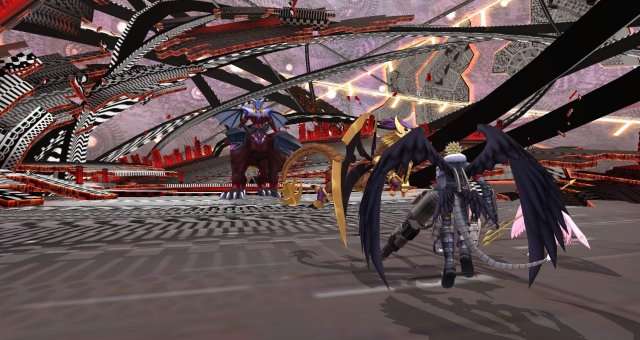
A lot of mechanics aren’t explained to you in this game, and even when they are, the explanations aren’t always the best. Here are a few of the more obscure mechanics, explained.
Guide to In-Depth and Hidden Mechanics
INT
The other stats are mostly self-explanatory, but INT is a bit less clear. INT actually governs three different things:
- The damage of your magic attacks.
- Your defense against magic attacks.
- The amount of HP your healing moves recover.
This means that physical attackers usually do not make very good healers, whereas magical attackers often do. However, status moves that do not heal HP, like Restore, work the same regardless of your INT, as do revival moves.
Basic Attacks
A Digimon’s “basic attack” is the attack it uses when you select “Attack” instead of selecting a skill. This attack is always physical, has a base power of 50, and has the same attribute as the Digimon using it. It is therefore useful mainly near the beginning of the game, or when you run out of SP, since it does not consume any. However, it does have another use when it comes to Digimon with certain support skills – namely, those that have a chance to inflict a status “when attacking.” Despite the wording, these support skills ONLY trigger for the basic attack, NOT skills. This gives basic attacks another niche, although not a very good one; most of the time, you’re still better off using your skills, especially if the status chance is small.
Damage Calculation
The formulas for damage in this game are very simple. They are as follows:
- For physical attacks: Damage = ATK x Move Power / DEF.
- For magical attacks: Damage = Attacker’s INT x Move Power x 1.5 / Defender’s INT.
As you can see, magical attacks are always 1.5 times more powerful than physical attacks of the same base power. This actually has the effect of nerfing INT’s defensive utility since, mathematically, it means that each point of DEF is more effective than each point of INT when defending. This in turn means that a Digimon only needs 2/3 as much DEF to reduce an attack by the same amount as a given value of INT.
Penetrating attacks use an even more basic formula:
- Damage = ATK or INT x Multiplier
The multiplier depends on the move itself and can be one of three values. For “medium” attacks, it is 1; for “strong” attacks, it is 1.8; and for “extra strong,” 2.5. Note that INT-based penetrating attacks do NOT get the additional 1.5x multiplier of most magical attacks.
Finally, after all other calculations, damage is always multiplied by a random value between 0.95 and 1.05 (for ±5% variation). This applies to both regular attacks and penetrating attacks.
Critical Hits & Combos
Critical hits are simple: they happen 5% of the time by default and deal 1.5x damage.
Combos are less simple, since they can come in chains of 2 or 3 and have differing effects for attack, healing, and buffing moves. Here are the multipliers for attack moves:
- 2x Chain Attack Skill: 1.5x damage.
- 3x Chain Attack Skill: 1.8x damage.
- 2x Chain Basic Attack: 2 hits.
- 3x Chain Basic Attack: 3 hits.
Meanwhile, the multipliers for healing skills are:
- 2x Chain Final Heal: 1.8x healing.
- 3x Chain Final Heal: 2.4x healing.
- 2x Chain Final Aura/Ocean Love: 1.8x healing.
- 3x Chain Final Aura/Ocean Love: 2.95x healing.
Charge skills work differently with combos, in that instead of multiplying the effect by a set amount, there is an element of randomness involved. They also do not appear to take into account how many Digimon participate in the combo, unlike other combos. Tests show that combo charge skills always increase the charged stat by 18-28%, regardless of all other factors.
Cooldowns
Every action during a battle has a hidden “cooldown” value that delays the user’s next turn by a certain amount. I am unsure of the exact formulas used, but this seems to work by subtracting from each battler’s cooldown until one of them has a remaining cooldown of 0, and then that battler may take an action. Digimon with higher SPD have their cooldowns reduced more quickly. By default, the turn order bar on the side of the screen shows future turns as if every Digimon used its basic attack, or another action with the minimum cooldown, but whenever a skill is highlighted it updates that Digimon’s position to show the order if it uses that skill this turn.
The cooldown of a skill depends on the skill itself, and cannot be viewed anywhere in the game, but by rule of thumb the more powerful the skill, the higher its cooldown. Penetrating attacks in particular tend to have very long cooldowns, as do Lucemon SM’s and ShineGreymon BM’s signature attacks.
PvP Healing
For whatever reason, moves that heal or revive are much less effective in PvP than in singleplayer. The amount of HP each one heals per Digimon is as follows:
- Final Heal: 1.5 x INT.
- Final Aura/Ocean Love: 1.2 x INT.
- Revive: 5% of Max HP.
- Perfect Revival: 25% of Max HP.
Note that the effects of chain combos are applied on top of these, multiplicatively, and work the same way as in singleplayer.
Helpless
For some reason the Helpless status effect, inflicted either by the move Support End or by Piedmon’s signature move Trump Sword, is treated differently from all other status effects. For one thing, it cannot be blocked by any means, including effects that block other status effects, such as the move Status Barrier or the item Master Barrier. Additionally, Varodurumon’s signature move Aurora Undulation, which normally removes negative status effects and stat drops from its user, does not remove Helpless. However, the moves Ocean Love and Restore do remove it.


Be the first to comment